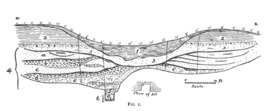|
Bolter End Sand Pit
Bolter End Sand Pit is a 0.33-hectare (0.82-acre) geological Site of Special Scientific Interest at Bolter End Common in Buckinghamshire.[1][2] The site is a disused pit with steep banks, overgrown, on private land with no public access.[3] It is conserved as a marginal facies of the Reading Formation found in the Lane End area containing beds of quartz and lydite gravel not found elsewhere in the formation and capped by a rare outcropping of London Clay proving the inclusions are an original part of the sequence and not a later addition. The inclusions are significant because they provide paleogeographic evidence for a riverine sequence bringing Early Cretaceous and Jurassic material, from a breach in the chalk in a north-westerly direction, to the Eocene sediments of the Reading Formation found at Lane End It was first studied by H.J Osborne White in 1906[4] at a different site south east of Lane End Holy Trinity Church where it was noted:
This Lane End pit became disused and was partially re-examined by S. W. Wooldridge and D. M. C. Gill in 1924[5] wherein he also described the Bolter End pit as displaying the same gravel features. Although the Bolter End pit is not capped by the London Clay, its horizon can be determined by the nearby Finings Wood and is not in doubt. Wooldridge further described the features in 1934[6] with additional evidence from the reservoir construction at Widdenton Park Wood, companion water tower at Finings Wood and associated pipe trenches.
There are no currently visible features of the pit and the interest could readily be investigated at any number of locations in the surrounding area. The pit does benefit from a chalk permeable floor and does not fill up with water in the wet season. However, through the later half of the 20th century, the pit had a reputation as a local unlicensed fly-tipping site. This waste was cleared in the early 2000s, however much of the waste was simply reburied in the deep chalk pits potentially creating an environmental hazard. References
|
||||||||||||||||
Portal di Ensiklopedia Dunia


